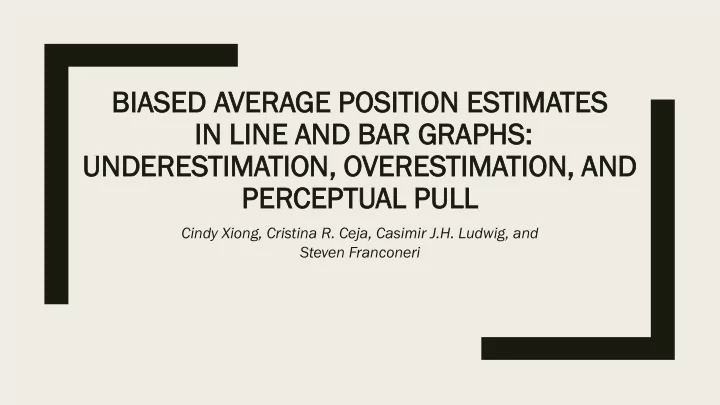

BI BIAS ASED ED AVER ERAGE GE PO POSIT ITION ION ES ESTIMA IMATES TES IN IN LI LINE E AN AND BAR D BAR GRA GRAPH PHS: S: UNDE DERES RESTIMA TIMATION, TION, OVER ERES ESTIMA TIMATION, TION, AN AND D PE PERCEPTU EPTUAL AL PU PULL LL Cindy Xiong, Cristina R. Ceja, Casimir J.H. Ludwig, and Steven Franconeri
Bia ias ■ Bias in position channel ■ Position is believed to be the most precise way to encode information ■ Data encoded in position is assumed to be perceived in an unbiased manner 2
Ex Experient perient Setup Setup ■ Two types of data series Line Bar ■ Uniform or Noisy 3
Ex Experient perient Setup Setup ■ Display Frame and Display Types 140 TOP 140 9.6 BOTTOM 0 9.6 x 2.8 in 538 x 140 pixels 4
Ex Experient perient Pr Procedures ocedures + 140 top/bottm line/bar 9.6 Fixation (500 ms) Stimulus Display (500 ms) Response (Until Response) Cue (500 ms) Mask (500 ms) 5
Ex Experient perient 1 ■ How accurately people can perceive average position of a single line or single set of bars in a graph? ■ Establish a baseline for later experiments ■ 576 trials, 288 trials for each line and bar position estimate, with half of trails for each condition displaying noisy and uniform data. 6
Ex Experient perient 1 R 1 Results esults 7
Ex Experient perient 1 R 1 Results esults 8
Ex Experient perient 1 R 1 Results esults ■ Underestimation of Lines – regardless appeared top or bottom, although more underestimation at the bottom – not depend on whether the line was noisy or uniform, although estimations of uniform data are more accurate and precise – not an artifact of poor average strategies (not averaging only high points and low points) – initial probe position affects error but not bias ■ Overestimation of Bars – same results as the lines’ 9
Ex Experient perient 2 ■ How this bias affected by the presence of an additional data series? – two lines (“compound line - line”) – two bars (“compound bar - bar”) ■ 240 trials, 120 trials for each line and bar average position estimation condition. ■ 144 control trials (experiment 1) were replicated. 10
Ex Experient perient 2 R 2 Results esults 11
Ex Experient perient 2 R 2 Results esults 12
“Perceptual Pull” ■ Underestimation of top line was exaggerated ■ Underestimation of bottom line was reduced ■ Overestimation of top bar was reduced ■ Overestimation of bottom bar was exaggerated 13
Ex Experient perient 3 ■ What determines the extent of perceptual pull? (Data-series? Perceptual similarity? ) – “compound line - bar”, “compound bar - line” ■ Experiment 1 and 2 results were replicated. 14
Ex Experient perient 3 R 3 Results esults 15
Ex Experient perient 3 R 3 Results esults 16
Ex Experient perient 3 R 3 Results esults ■ The effect of perceptual pull occurs across graphed data series types. ■ Strength of pulling across data series types? – Extent of perceptual pull does not depend on data series type 17
Conclusions onclusions an and d Ge General neral Gu Guidel ideline ine 1. Underestimation of lines and overestimation of bars 2. “Perceptual Pull”: - presence of an irrelevant line or set of bars in the same display pulled average position of estimations of a target line or set of bars toward the position of this irrelevant data series. 3. Perceptual pull is not dependent on graphed data series type. 1. Using bars to display data 2. Avoiding plotting two series in the same display 18
Criti ritique ue ■ Strengths – An area few have studied – Carefully designed experiments, considered potential causes and issues – Well planned future works ■ Weaknesses/Limitations – Short observation time (500ms) – Small experimental population 19
THANK YOU 20
Li Limitations mitations ■ Asymmetrical Biases ■ Aspect Ratio ■ Figure-Ground Encoding ■ Take Beyond Averaging ■ Reporting Mechanisms ■ Complex Real-World Stimuli ■ Untested Encodings 21
Ex Experient perient Setup Setup ■ Three Mean Values (for each top and bottom section) 22
Bia ias Is the population of Nova Scotia more or less than 200,000?I Ebbinghaus Illusion Anchoring Effect (perceptual) (cognitive) 23
Recommend
More recommend